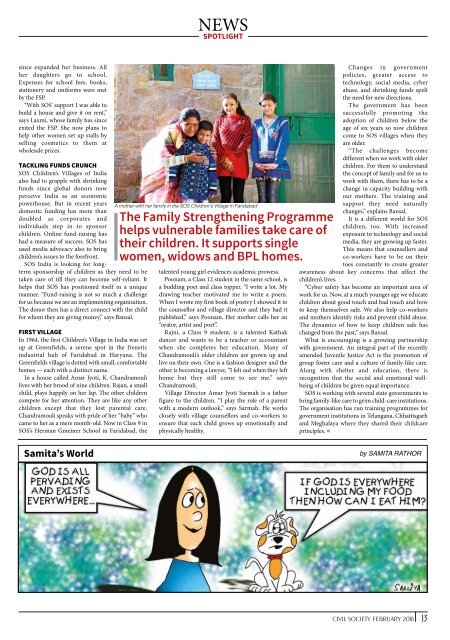Feb 2018
You also want an ePaper? Increase the reach of your titles
YUMPU automatically turns print PDFs into web optimized ePapers that Google loves.
NEWS<br />
spotlight<br />
since expanded her business. All<br />
her daughters go to school.<br />
Expenses for school fees, books,<br />
stationery and uniforms were met<br />
by the FSP.<br />
“With SOS' support I was able to<br />
build a house and give it on rent,”<br />
says Laxmi, whose family has since<br />
exited the FSP. She now plans to<br />
help other women set up stalls by<br />
selling cosmetics to them at<br />
wholesale prices.<br />
tackLiNG fUNds crUNch<br />
SOS Children’s Villages of India<br />
also had to grapple with shrinking<br />
funds since global donors now<br />
perceive India as an economic<br />
powerhouse. But in recent years<br />
domestic funding has more than<br />
doubled as corporates and<br />
individuals step in to sponsor<br />
children. Online fund-raising has<br />
had a measure of success. SOS has<br />
used media advocacy also to bring<br />
children’s issues to the forefront.<br />
SOS India is looking for longterm<br />
sponsorship of children as they need to be<br />
taken care of till they can become self-reliant. It<br />
helps that SOS has positioned itself in a unique<br />
manner. “Fund-raising is not so much a challenge<br />
for us because we are an implementing organisation.<br />
The donor then has a direct connect with the child<br />
for whom they are giving money,” says Bansal.<br />
first ViLLaGE<br />
In 1964, the first Children’s Village in India was set<br />
up at Greenfields, a serene spot in the frenetic<br />
industrial hub of Faridabad in Haryana. The<br />
Greenfields village is dotted with small, comfortable<br />
homes — each with a distinct name.<br />
In a house called Amar Jyoti, K. Chandramouli<br />
lives with her brood of nine children. Rajan, a small<br />
child, plays happily on her lap. The other children<br />
compete for her attention. They are like any other<br />
children except that they lost parental care.<br />
Chandramouli speaks with pride of her “baby” who<br />
came to her as a mere month-old. Now in Class 9 in<br />
SOS’s Herman Gmeiner School in Faridabad, the<br />
A mother with her family in the SOS Children’s Village in Faridabad<br />
The Family Strengthening Programme<br />
helps vulnerable families take care of<br />
their children. It supports single<br />
women, widows and BPL homes.<br />
talented young girl evidences academic prowess.<br />
Poonam, a Class 12 student in the same school, is<br />
a budding poet and class topper. “I write a lot. My<br />
drawing teacher motivated me to write a poem.<br />
When I wrote my first book of poetry I showed it to<br />
the counsellor and village director and they had it<br />
published,” says Poonam. Her mother calls her an<br />
“orator, artist and poet”.<br />
Rajni, a Class 9 student, is a talented Kathak<br />
dancer and wants to be a teacher or accountant<br />
when she completes her education. Many of<br />
Chandramouli’s older children are grown up and<br />
live on their own. One is a fashion designer and the<br />
other is becoming a lawyer, “I felt sad when they left<br />
home but they still come to see me,” says<br />
Chandramouli.<br />
Village Director Amar Jyoti Sarmah is a father<br />
figure to the children. “I play the role of a parent<br />
with a modern outlook,” says Sarmah. He works<br />
closely with village counsellors and co-workers to<br />
ensure that each child grows up emotionally and<br />
physically healthy.<br />
Changes in government<br />
policies, greater access to<br />
technology, social media, cyber<br />
abuse, and shrinking funds spelt<br />
the need for new directions.<br />
The government has been<br />
successfully promoting the<br />
adoption of children below the<br />
age of six years so now children<br />
come to SOS villages when they<br />
are older.<br />
“The challenges become<br />
different when we work with older<br />
children. For them to understand<br />
the concept of family and for us to<br />
work with them, there has to be a<br />
change in capacity building with<br />
our mothers. The training and<br />
support they need naturally<br />
changes,” explains Bansal.<br />
It is a different world for SOS<br />
children, too. With increased<br />
exposure to technology and social<br />
media, they are growing up faster.<br />
This means that counsellors and<br />
co-workers have to be on their<br />
toes constantly to create greater<br />
awareness about key concerns that affect the<br />
children’s lives.<br />
“Cyber safety has become an important area of<br />
work for us. Now, at a much younger age we educate<br />
children about good touch and bad touch and how<br />
to keep themselves safe. We also help co-workers<br />
and mothers identify risks and prevent child abuse.<br />
The dynamics of how to keep children safe has<br />
changed from the past,” says Bansal.<br />
What is encouraging is a growing partnership<br />
with government. An integral part of the recently<br />
amended Juvenile Justice Act is the promotion of<br />
group foster care and a culture of family-like care.<br />
Along with shelter and education, there is<br />
recognition that the social and emotional wellbeing<br />
of children be given equal importance.<br />
SOS is working with several state governments to<br />
bring family-like care to grim child-care institutions.<br />
The organisation has run training programmes for<br />
government institutions in Telangana, Chhattisgarh<br />
and Meghalaya where they shared their childcare<br />
principles. •<br />
samita’s World<br />
by SAMITA RATHOR<br />
Civil SoCiety FeBRUARy <strong>2018</strong><br />
13


